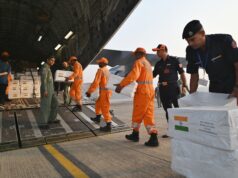 NEW DELHI, March 16 — A search of all islands in the Andaman and Nicobar archipelago for the missing Malaysia Airlines (MAS) Flight MH370 aircraft has so far, drawn a naught, officials of the Andaman and Nicobar Command (ANC) confirmed yesterday evening.
NEW DELHI, March 16 — A search of all islands in the Andaman and Nicobar archipelago for the missing Malaysia Airlines (MAS) Flight MH370 aircraft has so far, drawn a naught, officials of the Andaman and Nicobar Command (ANC) confirmed yesterday evening.
Two Indian Navy ships, along with those from other nations, are continuing their search at the location pinpointed by the Malaysian authorities but nothing has been spotted on the water.
“There has been no oil slick, no flotsam or a sonar ping to indicate that the jetliner crashed anywhere close to where the search operations are being carried out.
Details available with us are vague. Our search teams require a particular starting point from where to begin looking. We have searched all the islands but there are no signs of the aircraft,” The Times of India quoted ANC Chief of Staff Rear Admiral Sudhir Pillai, as saying.
Air traffic controllers at Kolkata have also ruled out the possibility of the missing aircraft flying through Indian airspace, one of the two possibilities that Malaysian Prime Minister Datuk Seri Najib Tun Razak suggested at a press conference in Kuala Lumpur yesterday.
The other alternative route that the flight – whose communication system is now believed to have been deliberately disabled – is to the Indian Ocean south of the Melaka Strait where the plane was last sighted on a Malaysian military radar, said the report.
According to Pillai, this would have taken the aircraft south of the Andamans. Speaking to the English Daily in Kolkata, air traffic controllers’ guild secretary Sugata Pramanik had said that while Flight MH370 could have avoided detection on the Secondary Surveillance Radar, the blip by the huge Boeing 777-200ER aircraft would surely have been spotted by the Indian Air Force (IAF) which uses Primary Surveillance Radars to detect such intrusions.
“If an aircraft wants to avoid being seen, they can easily become invisible to civilian radar by switching off the transponder. But it cannot avoid defence systems. The IAF has radars in multiple installations across the country and it is inconceivable that none of them spotted the odd blip with no flight clearance,” he said.
There are nine Air Defence Identification zones in the country that are manned round-the-clock to prevent an enemy aircraft from violating Indian airspace, said the report.
Kolkata Airport has an Automatic Dependence Surveillance Radar and Controller-Pilot Datalink Communication that enables it to not only trail planes when it is in the radar zone of 60 nautical miles or nearly 120km and beyond through very high frequency radio, but also through the data link when the plane goes out of voice communication range.
However, there are large areas in the Kolkata Flight Information Region, particularly over Bay of Bengal, that have no radar coverage at present.
A radar has been installed in Andaman and Nicobar Islands but is yet to be commissioned, said the daily.
— BERNAMA










